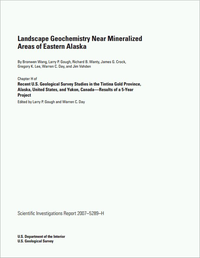The Pogo lode gold deposit was discovered in eastern
Alaska in the early 1990s and provided the opportunity
to study elemental distribution and mobility in the natural
environment prior to mine development. Studying
mineralized systems prior to mining allows us to compare
the natural biogeochemical signature in mineralized versus
nonmineralized areas. The resultant data and interpretation
also provide a baseline for evaluating what, if any, changes in
elemental distribution result from development. This report
investigates the chemistry of stream water, streambed sediment, and soil in the context of regional bedrock geology. The
major-ion chemistry of the waters reflects a rock-dominated
aqueous system, and the waters are classified as Ca2+ and
Mg2+ - HCO3- to Ca2+ and Mg2+ - SO4-2 waters. Creeks draining
the gneissic lithologies tend to be more sulfate dominated
than those draining the intrusive units. Sulfate also dominated
creeks draining mineralized areas; however, the underlying
paragneiss unit could be contributing substantially to the
sulfate concentration, and the sulfate concentration in these
creeks may reflect a complex baltholith-paragneiss boundary rather than mineralization. Arsenic concentrations in
bed sediments were elevated in mineralized areas relative
to nonmineralized areas. Elevated concentrations of nickel,
chromium, iron, manganese, and cobalt appear to reflect
the presence of ultramafic rocks in the drainage. In general, aqueous metal concentrations were below the State of
Alaska’s Aquatic Life Criteria and Drinking Water Standards,
with the exception of arsenic in stream water, which ranged
in concentration from less than 1 to 14 micrograms per liter
(μg/L) and exceeded the drinking water standard at one site.
The arsenic and antimony concentration in the A, B, and C
soil horizons ranged from 3 to 410 milligrams per kilogram
(mg/kg), 6.1 to 440 mg/kg, and 2 to 300 mg/kg, respectively, for arsenic and 0.4 to 24 mg/kg, 0.6 to 25 mg/kg, and 0.2 to
16 mg/kg, respectively, for antimony. The arsenic and antimony concentrations in stream waters correlate well with the
concentrations in soils. However, significantly less arsenic and
antimony was extracted from C horizon soils in water leaching
experiments, indicating that the arsenic and antimony in the
C horizon is present in a less available form than in the A or
B horizons. Arsenic and antimony uptake by grayleaf willow
(Salix glauca L.) appears minimal, with arsenic concentrations ranging from less than 0.01 to 0.14 mg/kg and antimony
concentrations ranging from less than 0.003 to 0.23 mg/kg
in willow leaves. In general, the highest concentrations of
both arsenic and antimony in water and soils were found
near mineralized areas. Elevated arsenic concentrations were
also found in bed sediments from mineralized areas. In these
sample matrices, the presence of arsenic and (or) antimony
was a good indicator of contact with mineralized rock units.


